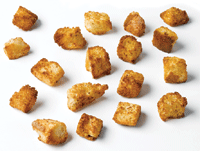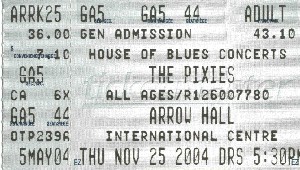Just a friendly reminder that there’s only one week left for the Naughty Reading Photo Contest. We have two entries and we’re hoping for more. So send those bad boys in before August 31 and you could be the winner of a $20 Powell gift card.
Category / Uncategorized
But He Can Still Be Seen Wearing Six Gallon Hats, Go Figure
James Tata does indeed like more than the Boss. Oh yes, he does.
Against the Crouton
The time has come to declare war on a culinary obstruction that has caused untold grief for contemporary eaters. I speak, of course, of the crouton: a vile, square-like embellishment that gets in the way of tasty vegetables and is completely incompatible with a salad’s raison d’etre. Should our war be successful (and I assure you, it is a jihad), I shall not be sorry to see the crouton expire. No Geneva Convention can possibly apply here. For the crouton is bunk and must be exterminated as swiftly as possible.
 Let’s quibble first over the crouton’s texture, which is often as hard and as impenetrable as the Berlin Wall. When one plunges a fork into a salad, one expects the tines to pierce through like a smooth needle through fabric. But let’s say that a crouton happens to be inside the natural trajectory of the fork’s thrust. As the fork dives into a pleasant leaf of lettuce, perhaps hitting a modest portion of a tomato or onion, perhaps pleasantly lubricated by viscious vinegar, the fork is hindered from its final descent because of this dreadful crouton. The fork user looks down, perplexed, and is likely to cry out, “What the fuck?” A moment of perfection, involving fork plunging into salad, forkful of salad moving to the mouth, and tasty digestion, has been denied. And it’s all because of the crouton.
Let’s quibble first over the crouton’s texture, which is often as hard and as impenetrable as the Berlin Wall. When one plunges a fork into a salad, one expects the tines to pierce through like a smooth needle through fabric. But let’s say that a crouton happens to be inside the natural trajectory of the fork’s thrust. As the fork dives into a pleasant leaf of lettuce, perhaps hitting a modest portion of a tomato or onion, perhaps pleasantly lubricated by viscious vinegar, the fork is hindered from its final descent because of this dreadful crouton. The fork user looks down, perplexed, and is likely to cry out, “What the fuck?” A moment of perfection, involving fork plunging into salad, forkful of salad moving to the mouth, and tasty digestion, has been denied. And it’s all because of the crouton.
Now granted, the optimist is likely to try again. But if the salad is polluted by too many croutons, then she will face the same calamity. The only cure for this condition is to adjust the alignment of the fork so that it resembles a spoon and scoop sideways. But since this is lettuce we’re talking about here, and since a fork is not, in fact, a spoon, but a four-pronged instrument featuring small rectangular abysses, the lettuce, being often a thin sheath that requires a forced coupling, is likely to fall between the tines. Even if we presume that the lettuce has formed a blanket to prevent any remnant vegetables from slipping through the cracks, the weight of the crouton might allow a fantastic shredded piece of carrot to fall asunder. Gravity, being what it is, will force all remaining salad components to fall from the fork, which is enough to bring even the most hearty optimists of our world to the same ineluctable cry: “What the fuck?”
From a taste perspective, the crouton also fails. Since the crouton has been fricaseed beyond any redemptive value, it seems designed to provide a harder counterpart (in short, variety) to the soft and naturally crispy texture of vegetables. But while you will encounter humans gnawing on raw carrots and tomatoes, you will very rarely see them snacking on a box of croutons. If the crouton itself cannot stand alone, why then should it partner up with the salad?
Further, there is the troubling fluctuation in the crouton’s hardness. Some croutons are somewhat manageable. Other croutons will crack molars. Nobody has been able to come up with a consistency or standard. Thus, the eater plagued by invasive croutons is doomed to this Russian Roulette.
Who was the asshole who came up with the crouton? Was he a sadist? And why did the crouton catch on? Surely, the crouton’s enduring legacy means that someone must like it. If this is the case, where then are the crouton fan clubs?
Perhaps the ultimate test is the crouton’s cultural bearing: While one might prepare a sonnet to a lover, comparing testicles to ripe cherry tomatoes or wanting to “wrap around you like lettuce” or “lick your sweat off like dressing,” can one ensconce the crouton in a salacious or even a romantic context? Not at all. There isn’t a part of the body that is as square or as tough as the crouton. No surprise that, when compared with the crouton, the human body is much more interesting.
The Pixies Are Dead
Jeff points to the sad honest truth. The Pixies are sellouts. Big time. Their ticket prices are aprocryphal (anywhere from $35-60 a show). And this concert rider illustrates that the Pixies are no different from any other bloated band making the rounds.
 “Veggie platter with hummous and sour cream dip?” Exactly 48 bottles of non-alcoholic beer? Fuck you, Black Francis. Eat me, Kim Deal.
“Veggie platter with hummous and sour cream dip?” Exactly 48 bottles of non-alcoholic beer? Fuck you, Black Francis. Eat me, Kim Deal.
I have, in the face of several opportunities presented to me, resisted the impulse to plop down such a staggering sum of cash for a Pixies show in 2004 and 2005. It hasn’t been easy. But now, after this unexpected hummous news, it’s a slam dunk decision. The Pixies are dead to me.
It would be one thing if the Pixies were honest about their avarice. Perhaps calling this “The Pixies Retirement Fund Tour” would come closer to the truth. That’s essentially the approach the Sex Pistols took a few years ago and I resepcted John Lydon for his unapologetic and forthright commercialism. Which was more than you can say for most reunions that hide behind the shady veneer of “We’re getting together just for old time’s sake!”
But if you were of a certain age about fifteen years ago, the Pixies encompassed a sound and a feeling that was uncompromising, independent, and sui generis. The Pixies demonstrated that goofiness and rage and bitterness and carrying on with a strange optimism could stem from a carefully produced guitar sound that nobody else cutting records back then came close to — a sound that, in fact, Kurt Cobain unapologetically pilfered.
They built up their audience with impressionable listeners like me, who lapped up Surfer Rosa and Doolittle, knowing that what was on these albums was genuine and unadulterated. So in the Pixies’ case, it’s especially a shame that these days, the Pixies are more about replaying the greatest hits and cashing in, rather than how it used to be: giving a good show and evolving their sound.
Vanity Presses: The New Matchmakers?
While some publishers refrain from reading anything in the slush pile (with understandable justification) and it’s safe to say that vanity presses remain for the most part a successful mechanism to gouge unpublishable authors, this Telegraph article imputes a potential “gold mine” within these flashless fens.
Consider the unlikely success of medical professor David Alric. Alric wrote a children’s novel called The Promised One and his tale of a schoolgirl who can talk to animals couldn’t find a publisher for his fiction — despite having authored several books on medicine. Alric paid out £10,000 to a vanity press and has managed to sell 80-100 books every Saturday at his local bookstore. He ordered a second run and he keeps the spare copies in his garage.
Alric’s success had no marketing behind it. There are no reputable reviews that appear to be available online. Nor does Alric have a website. There would seem to be little going for Alric but word of mouth.
 But the real question here is whether this is a case of publishers being out of touch with the public or, if Alric’s book is a shaggy dog and if the peanut gallery here is ready to leap atop the elitist parpaet, the public perhaps having a paucity of literary taste. Either way, Alric’s success clearly indicates that the chasm between authors, publishers, and reading audience remains wide and needs to be bridged. And it’s enough for this showtunes-loving heterosexual to start singing “Matchmaker” and perhaps start a new publishing house styled “Chava & Hodel.”
But the real question here is whether this is a case of publishers being out of touch with the public or, if Alric’s book is a shaggy dog and if the peanut gallery here is ready to leap atop the elitist parpaet, the public perhaps having a paucity of literary taste. Either way, Alric’s success clearly indicates that the chasm between authors, publishers, and reading audience remains wide and needs to be bridged. And it’s enough for this showtunes-loving heterosexual to start singing “Matchmaker” and perhaps start a new publishing house styled “Chava & Hodel.”